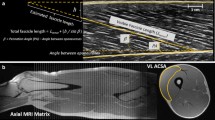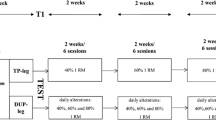Abstract
Purpose
To analyse the muscle adaptations induced by two protocols of isometric training performed at different muscle lengths.
Methods
Twenty-eight subjects were divided into three groups: one (K90) performed isometric training of the knee extensors at long muscle lengths (90° of knee flexion) for 8 weeks, and the second group (K50) at short muscle lengths (50°). The subjects of the third group acted as controls. Isokinetic dynamometry was utilized to analyse the net moment–angle relationship and vastus lateralis muscle thickness at three different locations, and pennation angles and fascicle length at 50 % of thigh length were measured at rest with ultrasonography.
Results
Only subjects from K90 group showed significant increases in isokinetic strength (23.5 %, P < 0.001), while K50 group showed no increases in isokinetic strength: (10 %, P > 0.05). There was a shift in the angle of peak torque of the K90 group to longer muscle lengths (+14.6 %, P = 0.002) with greater increases in isokinetic strength, while the K50 angle shifted to shorter muscle lengths (−7.3 %, P = 0.039). Both training groups showed significant increases in muscle thickness, (K90 9–14 % vs. K50 5–9 %) but only K90 significantly increased their pennation angles (11.7 %, P = 0.038). Fascicle lengths remained unchanged.
Conclusions
Isometric training at specific knee angles led to significant shifts of peak torque in the direction of the training muscle lengths. The greater strength gains and the architectural changes with training at long muscle lengths probably come from a combination of different factors, such as the different mechanical stresses placed upon the muscle–tendon complex.


Similar content being viewed by others
Abbreviations
- ANOVA:
-
Analysis of variance
- BF:
-
Biceps femoris long head
- CV:
-
Coefficient of variation
- ES:
-
Effect size
- EMG:
-
Electromyography
- KE:
-
Knee extensors
- MT:
-
Muscle thickness
- RMS:
-
Root mean square
- ROM:
-
Range of movement
- VL:
-
Vastus lateralis
References
Aagaard P, Simonsen EB, Trolle M, Bangsbo J, Klausen K (1995) Isokinetic hamstring/quadriceps strength ratio: influence from joint angular velocity, gravity correction and contraction mode. Acta Physiol Scand 154(4):421–427
Aagaard P, Andersen JL, Dyhre-Poulsen P, Leffers AM, Wagner A, Magnusson SP, Halkjaer-Kristensen J, Simonsen EB (2001) A mechanism for increased contractile strength of human pennate muscle in response to strength training: changes in muscle architecture. J Physiol 534(Pt. 2):613–623
Altenburg TM, de Haan A, Verdijk PW, van Mechelen W, de Ruiter CJ (2009) Vastus lateralis single motor unit EMG at the same absolute torque production at different knee angles. J Appl Physiol 107(1):80–89. doi:10.1152/japplphysiol.90322.2008
Ando R, Taniguchi K, Saito A, Fujimiya M, Katayose M, Akima H (2014) Validity of fascicle length estimation in the vastus lateralis and vastus intermedius using ultrasonography. J Electromyogr Kinesiol 24(2):214–220. doi:10.1016/j.jelekin.2014.01.003
Babault N, Pousson M, Michaut A, Van Hoecke J (2003) Effect of quadriceps femoris muscle length on neural activation during isometric and concentric contractions. J Appl Physiol 94(3):983–990. doi:10.1152/japplphysiol.00717.2002
Balnave CD, Allen DG (1996) The effect of muscle length on intracellular calcium and force in single fibres from mouse skeletal muscle. J Physiol 492(Pt 3):705–713
Blazevich AJ (2006) Effects of physical training and detraining, immobilisation, growth and aging on human fascicle geometry. Sports Med 36(12):1003–1017 (pii:36122)
Blazevich AJ, Gill ND, Zhou S (2006) Intra- and intermuscular variation in human quadriceps femoris architecture assessed in vivo. J Anat 209(3):289–310. doi:10.1111/j.1469-7580.2006.00619.x
Blazevich AJ, Cannavan D, Coleman DR, Horne S (2007) Influence of concentric and eccentric resistance training on architectural adaptation in human quadriceps muscles. J Appl Physiol 103(5):1565–1575. doi:10.1152/japplphysiol.00578.2007
Blazevich AJ, Cannavan D, Horne S, Coleman DR, Aagaard P (2009) Changes in muscle force-length properties affect the early rise of force in vivo. Muscle Nerve 39(4):512–520. doi:10.1002/mus.21259
Boakes JL, Foran J, Ward SR, Lieber RL (2007) Muscle adaptation by serial sarcomere addition 1 year after femoral lengthening. Clin Orthop Relat Res 456:250–253. doi:10.1097/01.blo.0000246563.58091.af
Bowers EJ, Morgan DL, Proske U (2004) Damage to the human quadriceps muscle from eccentric exercise and the training effect. J Sports Sci 22(11–12):1005–1014
Brockett CL, Morgan DL, Proske U (2004) Predicting hamstring strain injury in elite athletes. Med Sci Sports Exerc 36(3):379–387 (pii:00005768-200403000-00005)
Brughelli M, Cronin J (2007) Altering the length-tension relationship with eccentric exercise: implications for performance and injury. Sports Med 37(9):807–826 (pii:3794)
Brughelli M, Cronin J, Nosaka K (2010a) Muscle architecture and optimum angle of the knee flexors and extensors: a comparison between cyclists and Australian Rules football players. J Strength Cond Res 24(3):717–721. doi:10.1519/JSC.0b013e318197009a
Brughelli M, Mendiguchia J, Nosaka K, Idoate F, Arcos AL, Cronin J (2010b) Effects of eccentric exercise on optimum length of the knee flexors and extensors during the preseason in professional soccer players. Phys Ther Sport 11(2):50–55. doi:10.1016/j.ptsp.2009.12.002
Burgess KE, Connick MJ, Graham-Smith P, Pearson SJ (2007) Plyometric vs. isometric training influences on tendon properties and muscle output. J Strength Cond Res 21(3):986–989. doi:10.1519/R-20235.1
Cohen J (1988) Statistical power analysis for the behavioral sciences, 2nd edn. Erlbaum Associates, Hillsdale
Csapo R, Alegre LM, Baron R (2011) Time kinetics of acute changes in muscle architecture in response to resistance exercise. J Sci Med Sport 14(3):270–274. doi:10.1016/j.jsams.2011.02.003
de Ruiter CJ, de Boer MD, Spanjaard M, de Haan A (2005) Knee angle-dependent oxygen consumption during isometric contractions of the knee extensors determined with near-infrared spectroscopy. J Appl Physiol 99(2):579–586. doi:10.1152/japplphysiol.01420.2004
Erskine RM, Jones DA, Williams AG, Stewart CE, Degens H (2010) Resistance training increases in vivo quadriceps femoris muscle specific tension in young men. Acta Physiol (Oxf) 199(1):83–89. doi:10.1111/j.1748-1716.2010.02085.x
Folland JP, Williams AG (2007) The adaptations to strength training: morphological and neurological contributions to increased strength. Sports Med 37(2):145–168 (pii:3724)
Hermens HJ, Freriks B, Disselhorst-Klug C, Rau G (2000) Development of recommendations for SEMG sensors and sensor placement procedures. J Electromyogr Kinesiol 10(5):361–374 (pii:S1050-6411(00)00027-4)
Herzog W, Guimaraes AC, Anton MG, Carter-Erdman KA (1991) Moment-length relations of rectus femoris muscles of speed skaters/cyclists and runners. Med Sci Sports Exerc 23(11):1289–1296
Heslinga JW, te Kronnie G, Huijing PA (1995) Growth and immobilization effects on sarcomeres: a comparison between gastrocnemius and soleus muscles of the adult rat. Eur J Appl Physiol Occup Physiol 70(1):49–57
Huijing PA (1998) Muscle, the motor of movement: properties in function, experiment and modelling. J Electromyogr Kinesiol 8(2):61–77
Huijing PA, Jaspers RT (2005) Adaptation of muscle size and myofascial force transmission: a review and some new experimental results. Scand J Med Sci Sports 15(6):349–380. doi:10.1111/j.1600-0838.2005.00457.x
Hunter KD, Faulkner JA (1997) Pliometric contraction-induced injury of mouse skeletal muscle: effect of initial length. J Appl Physiol 82(1):278–283
Johansson H, Sjölander P, Sojka P (1991) A sensory role for the cruciate ligaments. Clin Orthop Relat Res 268:161–178
Kubo K, Ohgo K, Takeishi R, Yoshinaga K, Tsunoda N, Kanehisa H, Fukunaga T (2006) Effects of isometric training at different knee angles on the muscle-tendon complex in vivo. Scand J Med Sci Sports 16(3):159–167. doi:10.1111/j.1600-0838.2005.00450.x
Lindh M (1979) Increase of muscle strength from isometric quadriceps exercises at different knee angles. Scand J Rehabil Med 11(1):33–36
Lynn R, Morgan DL (1994) Decline running produces more sarcomeres in rat vastus intermedius muscle fibers than does incline running. J Appl Physiol 77(3):1439–1444
McMahon G, Morse CI, Burden A, Winwood K, Onambele GL (2013) Muscular adaptations and insulin-like growth factor-I (IGF-I) responses to resistance training are stretch-mediated. Muscle Nerve. doi:10.1002/mus.23884
Noorkoiv M, Stavnsbo A, Aagaard P, Blazevich AJ (2010) In vivo assessment of muscle fascicle length by extended field-of-view ultrasonography. J Appl Physiol (1985) 109(6):1974–1979. doi:10.1152/japplphysiol.00657.2010
Noorkoiv M, Nosaka K, Blazevich AJ (2014) Neuromuscular adaptations associated with knee joint angle-specific force change. Med Sci Sports Exerc. doi:10.1249/MSS.0000000000000269
Pal S, Langenderfer JE, Stowe JQ, Laz PJ, Petrella AJ, Rullkoetter PJ (2007) Probabilistic modeling of knee muscle moment arms: effects of methods, origin-insertion, and kinematic variability. Ann Biomed Eng 35(9):1632–1642. doi:10.1007/s10439-007-9334-6
Philippou A, Bogdanis GC, Nevill AM, Maridaki M (2004) Changes in the angle-force curve of human elbow flexors following eccentric and isometric exercise. Eur J Appl Physiol 93(1–2):237–244. doi:10.1007/s00421-004-1209-z
Reeves ND, Narici MV, Maganaris CN (2004a) Effect of resistance training on skeletal muscle-specific force in elderly humans. J Appl Physiol 96(3):885–892. doi:10.1152/japplphysiol.00688.2003
Reeves ND, Narici MV, Maganaris CN (2004b) In vivo human muscle structure and function: adaptations to resistance training in old age. Exp Physiol 89(6):675–689. doi:10.1113/expphysiol.2004.027797
Reeves ND, Maganaris CN, Longo S, Narici MV (2009) Differential adaptations to eccentric versus conventional resistance training in older humans. Exp Physiol 94(7):825–833. doi:10.1113/expphysiol.2009.046599
Savelberg HH, Meijer K (2003) Contribution of mono- and biarticular muscles to extending knee joint moments in runners and cyclists. J Appl Physiol 94(6):2241–2248. doi:10.1152/japplphysiol.01001.2002
Swatland HJ (1980) Analysis of growth in a complex muscle (M. supracoracoideus, Anas platyrhynchos). Growth 44(2):139–146
Ullrich B, Brueggemann GP (2008) Moment–knee angle relation in well trained athletes. Int J Sports Med 29(8):639–645. doi:10.1055/s-2007-989322
Ullrich B, Kleinoder H, Bruggemann GP (2009) Moment–angle relations after specific exercise. Int J Sports Med 30(4):293–301. doi:10.1055/s-0028-1104589
Weir JP, Housh TJ, Weir LL, Johnson GO (1995) Effects of unilateral isometric strength training on joint angle specificity and cross-training. Eur J Appl Physiol Occup Physiol 70(4):337–343
Acknowledgments
This study was supported by research funds from the regional government of Castilla-La Mancha, Spain (project PII1I09-0192-6593).
Conflict of interest
No conflicts of interest are declared by the authors.
Author information
Authors and Affiliations
Corresponding author
Additional information
Communicated by Olivier Seynnes.
Rights and permissions
About this article
Cite this article
Alegre, L.M., Ferri-Morales, A., Rodriguez-Casares, R. et al. Effects of isometric training on the knee extensor moment–angle relationship and vastus lateralis muscle architecture. Eur J Appl Physiol 114, 2437–2446 (2014). https://doi.org/10.1007/s00421-014-2967-x
Received:
Accepted:
Published:
Issue Date:
DOI: https://doi.org/10.1007/s00421-014-2967-x




